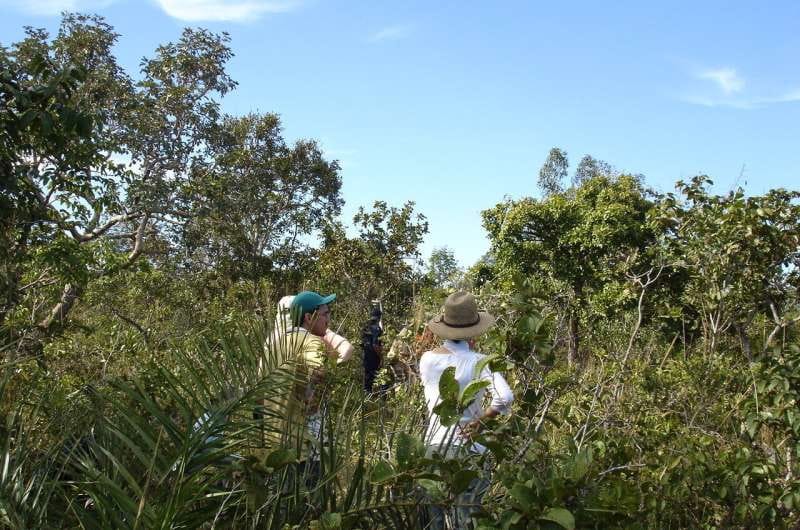This post was originally published on Eco Watch
In the Cerrado — the largest and most plant-diverse savanna in the world — scientists have discovered that just 30 tree species account for almost half of the ecosystem’s trees.
The phenomenon is called “hyperdominance” and has major implications for the understanding and conservation of the Cerrado, a press release from University of Exeter said.
For the study, researchers from Brazil, the Netherlands and the United Kingdom drew upon data from more than 200 field plots, along with spatial modeling and satellite imagery.
Researchers carry out field work in the Cerrado. Professor Ted Feldpausch, University of Exeter
They found that less than two percent of the 1,605 tree species found in the Cerrado accounted for nearly half of all trees in the unique savanna. Among the group of hyperdominant trees, one in 14 were of a particular species: Qualea parviflora.
“We were surprised by this level of hyperdominance in such a diverse ecosystem,” said lead author of the study Dr. Facundo Alvarez with the State University of Mato Grosso (UNEMAT), in the press release. “This pattern is similar to what’s been observed in the Amazon rainforest, although the Cerrado is a savanna. Our research also determined that the Cerrado has lost an estimated 24 billion trees since 1985 – a staggering figure equivalent to three times the Earth’s current human population. Understanding the dominance of these few species is essential in light of such losses.”
The Cerrado spans two million square kilometers, an area as large as France, Germany, Spain, Italy and England combined. It serves as a gateway to Amazonia and plays an essential part in sequestering carbon and supplying clean water.

Ecosystems such as the Amazon and Cerrado where just a few species are hyperdominant highlight the risk of the species loss these biomes face due to deforestation, fragmentation and land use changes.
“When so many ecosystem processes are concentrated in 30 or so individual species it means that if you disrupt this system, for example through climate change, then depending on how those species respond to that disruption there’s a risk of losing the species that are key to maintaining core functionality of the savanna as a savanna,” said Ted Feldpausch, co-author of the study and a professor at University of Exeter, in the press release.
Feldpausch explained that, since the stability and functioning of the Cerrado are narrowly based due to the domination of just 30 species, focusing on those could assist researchers in understanding the functioning of this vast ecosystem.
“It could help us make predictions about how the system as a whole is going to function – and potentially how it will respond to disruptions, whether from changing fire regimes or a changing climate,” Feldpausch said.
Lead co-author of the study Professor Beatriz Marimon, a professor with UNEMAT, said it would help with conservation as well.
“[K]nowing where we find higher and lower diversity; it’s going to help with management – so knowing, for example, whether these are species are more or less adaptive to fire; and if we’re trying to restore areas, understanding these few species is going to help with that too,” Marimon said.
The Cerrado is a critically endangered biome, more than half of which has been deforested and just eight percent of which is protected.
Up to now, the Cerrado has been a barrier separating Amazonia from urbanized and densely populated southeastern Brazil. It regulates climate while contributing to the water supply of major cities.
“Yet global environmental policies continue to overlook the Cerrado,” said co-author of the study Professor Ben Hur Marimon Junior with UNEMAT. “Its protection must become an international priority — not a burden carried solely by local communities.”
The study, “Tree species hyperdominance and rarity in the South American Cerrado,” was published in the journal Communications Biology.
The post World’s Most Diverse Savanna Dominated by Just 30 Tree Species: Study appeared first on EcoWatch.





0 Comments